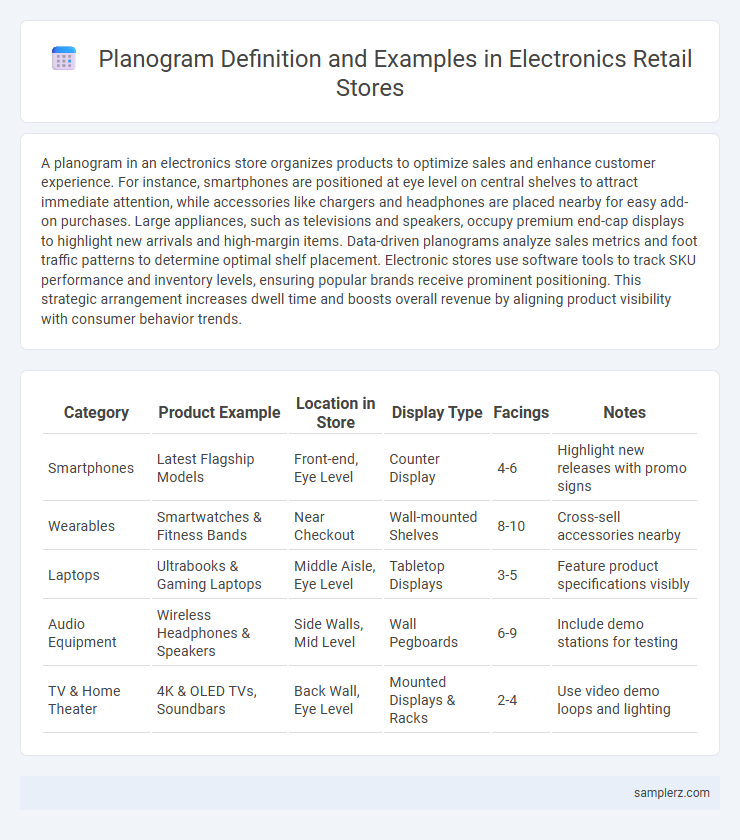A planogram in an electronics store organizes products to optimize sales and enhance customer experience. For instance, smartphones are positioned at eye level on central shelves to attract immediate attention, while accessories like chargers and headphones are placed nearby for easy add-on purchases. Large appliances, such as televisions and speakers, occupy premium end-cap displays to highlight new arrivals and high-margin items. Data-driven planograms analyze sales metrics and foot traffic patterns to determine optimal shelf placement. Electronic stores use software tools to track SKU performance and inventory levels, ensuring popular brands receive prominent positioning. This strategic arrangement increases dwell time and boosts overall revenue by aligning product visibility with consumer behavior trends.
Table of Comparison
| Category | Product Example | Location in Store | Display Type | Facings | Notes |
|---|---|---|---|---|---|
| Smartphones | Latest Flagship Models | Front-end, Eye Level | Counter Display | 4-6 | Highlight new releases with promo signs |
| Wearables | Smartwatches & Fitness Bands | Near Checkout | Wall-mounted Shelves | 8-10 | Cross-sell accessories nearby |
| Laptops | Ultrabooks & Gaming Laptops | Middle Aisle, Eye Level | Tabletop Displays | 3-5 | Feature product specifications visibly |
| Audio Equipment | Wireless Headphones & Speakers | Side Walls, Mid Level | Wall Pegboards | 6-9 | Include demo stations for testing |
| TV & Home Theater | 4K & OLED TVs, Soundbars | Back Wall, Eye Level | Mounted Displays & Racks | 2-4 | Use video demo loops and lighting |
Introduction to Electronics Store Planograms
Electronics store planograms strategically arrange products such as smartphones, laptops, and accessories to maximize visibility and sales. By grouping items like headphones near related gadgets, planograms enhance customer experience and streamline inventory management. Effective planograms utilize shelf space, product placement, and category segmentation to boost in-store engagement and optimize revenue.
Key Elements of a Successful Electronics Planogram
A successful electronics planogram strategically places high-demand products, such as smartphones and laptops, at eye level to maximize visibility and sales. It ensures organized product grouping by brand and category, making it easier for customers to compare features and prices. Effective use of signage and interactive displays enhances the shopping experience and drives customer engagement in the electronics section.
Planogram Example: Smartphone Display Arrangement
A smartphone display arrangement in an electronics store planogram strategically places high-demand models at eye level to boost visibility and sales. Accessories like chargers and earbuds are positioned nearby to encourage cross-selling and increase average transaction value. Shelf labels and digital price tags provide clear product information, enhancing the overall customer shopping experience.
Best Practices for TV and Display Shelving
Effective planograms for electronics stores emphasize strategic placement of TVs on eye-level shelves to maximize visibility and customer engagement. Organizing display shelving by screen size, brand, and technology type--such as OLED, QLED, and LED--facilitates intuitive navigation and comparison. Incorporating clear signage and interactive displays enhances the in-store experience while optimizing product accessibility and inventory management.
Accessory Placement: Headphones, Chargers, and Cables
In electronics stores, planograms strategically position headphones, chargers, and cables near high-traffic zones like checkout counters and main aisles to boost visibility and impulse buys. Headphones are commonly displayed at eye level with clear labeling for brand and type, while chargers and cables are grouped by device compatibility and charging speed to simplify customer choice. This organized layout enhances customer experience and maximizes sales by facilitating easy access to frequently purchased accessories.
Maximizing Impulse Buys with Checkout Area Planograms
Checkout area planograms in electronics stores strategically position small, high-demand items like phone chargers, earbuds, and screen protectors near the register to maximize impulse buys. Eye-level placement and clear signage enhance product visibility and encourage last-minute purchases. Optimizing this layout increases average transaction value and drives incremental revenue.
Seasonal and Promotional Product Placement Strategies
Seasonal and promotional product placement strategies in electronics stores involve positioning high-demand items like smart home devices and holiday-themed gadgets near store entrances or checkout counters to maximize visibility during key shopping periods. Utilizing endcaps and dedicated displays for limited-time offers on headphones or gaming consoles enhances customer engagement and drives impulse purchases. Data-driven planograms prioritize products aligned with seasonal trends and promotional calendars to optimize floor space and increase sales velocity.
Cross-Merchandising Techniques for Electronics
Cross-merchandising in electronics stores often involves displaying complementary products together, such as pairing smartphones with cases and screen protectors to enhance customer convenience and increase sales. Strategic placement of accessories like headphones next to audio devices improves customer experience and encourages multiple purchases. Utilizing vertical merchandising by grouping tech gadgets with compatible chargers or smart home devices maximizes shelf space and drives checkout efficiency.
Data-Driven Planogram Adjustments in Electronics Retail
Data-driven planogram adjustments in electronics retail optimize shelf layouts using real-time sales data, consumer behavior analytics, and inventory levels to enhance product visibility and increase turnover rates. For instance, an electronics store may reposition high-demand items like headphones and chargers at eye level based on heatmaps and purchase frequency, while seasonal gadgets are dynamically rotated to maintain customer interest. Leveraging machine learning algorithms, these planograms continually adapt to emerging trends and competitor pricing, maximizing both shelf space efficiency and revenue growth.
Enhancing Customer Experience with Interactive Displays
Interactive displays in electronics store planograms significantly enhance the customer experience by allowing hands-on engagement with gadgets such as smartphones, tablets, and smart home devices. Strategically placed interactive kiosks provide detailed product information, user reviews, and comparison tools, aiding informed purchasing decisions. Incorporating demo zones with touchscreens and virtual assistants increases dwell time and customer satisfaction, driving higher sales conversions.

example of planogram in electronics store Infographic
 samplerz.com
samplerz.com